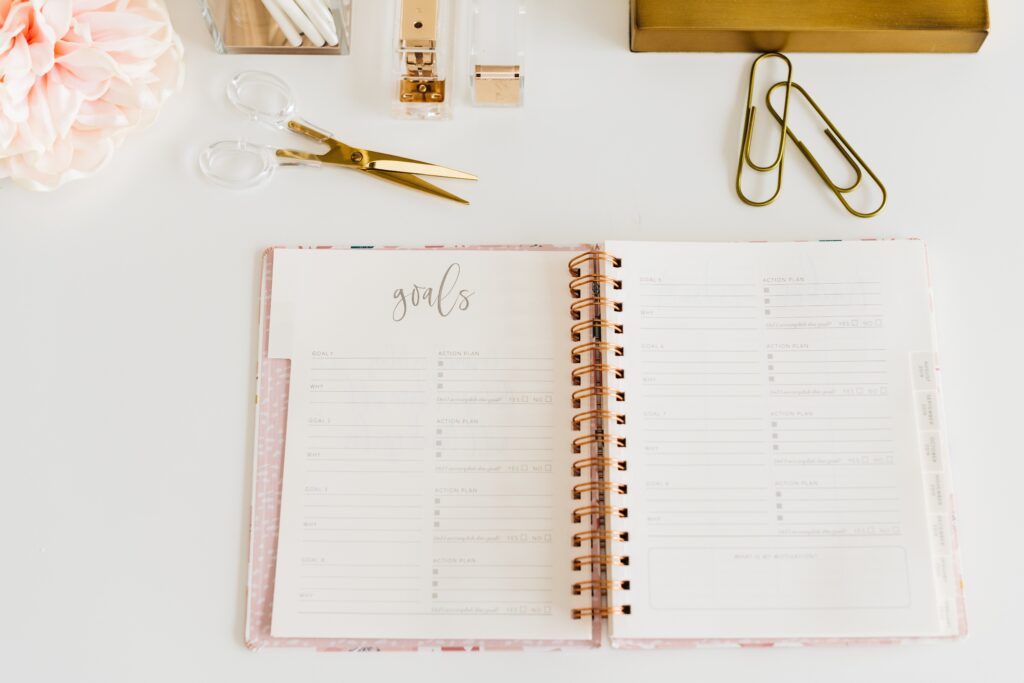Sharing is caring!
How to Create Attainable Health Goals
Do you have this overall feeling of wanting to be healthier but have no idea where to start? Do you make health goals that sound like this: “I’m going to stop eating junk food” or “I’m going to exercise more.” And you have the best of intentions but somewhere down the line during your journey your health goals and your healthy behaviors fizzle out. Then you’re left feeling discouraged and confused as to where it all went wrong.
Well, I’m writing this post to give you some solid research-based guidelines on how to create sturdy health goals. I want to walk you through the journey from start to finish! Let’s begin!
This post may contain affiliate links to products. I make a commission if they’re purchased using the links I provide at no cost to you. Please go to my terms and conditions page for more information.
Health Goals: Where to Start?
The three focus areas that I post most about on my blog are self-care psychology, fitness, and nutrition. For that reason, we will be covering how to create “health” goals involving those three focus areas. To create health goals, you must ask yourself some questions.
- What focus area do you want to make changes to? Fitness, nutrition, the way you handle your thoughts/moods/feelings?
- In consideration of that focus area: What exactly do you want to change?
- Your entire diet or just add some healthy veggies?
- Do you want to start an exercise routine or just add to an already existing exercise routine?
- Do you feel that you can change the way you handle stress or your feelings and thoughts?
- Where are you starting and where do you want to end up?
The "How to" On Creating Health Goals
I’m going to give you some very basic information on how to create health goals using some helpful tools and behaviorism! I’ll walk you through this process from beginning to end!
- Choose the health behavior that you want to change. I chose the word behavior because that’s something that we can identify and control.
- Take baseline data on that behavior. Read more about baseline data and how to change habits on my blog post here.
- Once you’ve taken baseline data on that behavior, you can then create a SMART goal
- From your SMART goal you can create weekly action steps
Simple right? I’m going to map out how this process works with an example.
An Example Scenario
Our scenario starts with a woman named Liz and she wants to change two things. She wants to change her consumption of “junk food” and she wants to start an exercise routine.
First, she needs to identify the behaviors that she wants to change when it comes to “junk food” consumption and exercising. Without this information health goals cannot be created.
Liz eats drive through food about 5 times a week during her lunch hour. She decides this behavior is what she wants to change when it comes to “junk food” consumption.
Liz does not have an exercise routine at all and doesn’t know where to start. She decides she wants to increase (from 0) an exercise routine.
So far, we have two behaviors identified for Liz.
- Focus areas: nutrition & fitness
- Behaviors: Drive through meal consumption & cardio exercise/strength training exercise behaviors
- Baseline data on behaviors: 5 drive through meals a week & 0 Exercising
Now we create SMART Goals.
But what is a SMART Goal?
Creating a S.M.A.R.T Health Goal
Here is what each letter in the acronym S.M.A.R.T. stands for:
S: Specific
- Create goals that list out the behaviors that you want to engage in. Where do they take place? With whom? When? Which foods or exercise will be changing? What will you need? Why…just good practice to keep your “why” in mind!
M: Measurable
- You must be able to measure these behaviors. Attach numbers everything involving your goals so that you can identify if you’re reaching them or not. Which can then lead to identifying things that are working or things that are getting in the way (barriers)
A: Actionable
- Your goals must include behaviors that can be considered “action steps.” If you don’t identify actions steps, then you can’t determine whether or not your behaviors are changing. More on this in a bit.
R: Realistic
- Your goals and resulting action steps have to be realistic. It’s not realistic to go from never exercising at all to exercising 7 days a week for 2 two-hour stints or losing 100 pounds in 1 month. It’s important to create goals that are just above our threshold of skill and ability versus way out of reach.
T: Time Bound
- All goals and action steps need to be completed in a determined window of time. For example you might shape your goal like this: Within 3 months I want to have lost 12-15 pounds and I want to have an exercise routine that includes me jogging for 20 minutes 3 times a week.
Back to Liz...
Liz wants to decrease junk food consumption and increase exercise. She identified behaviors, took baseline data on those behaviors and is ready to make a SMART goal!
Below is a detailed example of creating a SMART goal, when to graduate to a more challenging action step and when to determine that you have arrived at the accomplishment of your goals. Most people are happy with a stopping point after which they simply maintain their new-and-improved health behaviors.
The Nitty Gritty of SMART Health Goals
What follows can seem like a lot but bare with me! Each detail of these goals is important to accountability and growth.
In three months, Liz wants to reach the following goals:
Nutrition: 5 to-go meals from Salata (buffet style salad restaurant) per week INSTEAD of any other fast-food restaurants
Her weekly action step: Each week, Liz will increase her Salata to-go meals by one
Meal Graduation Criteria: 1 to-go Salata meal until she accomplishes 5 to-go Salata lunch time meals per week.
Fitness:
- Liz chooses a # for the goal she creates for reps done in one round (per muscle group) of strength training.
- She determines a duration (amount of time doing something) and frequency (how often per “time-period”) goal for jogging
- She also chooses a number of crunches she wants to complete per round of core exercises before moving on to different core exercises
The fitness goal can look like this for those of you that are looking for a detailed example on where Liz started, how she increases the challenge of her action steps and then where she decides that she’s reached her goal.
After taking baseline data on how long she could jog without giving up and how many reps/rounds she could do of bicep curls, triceps curls, lunges, squats, and crunches she created the following goals:
Cardio Exercise 3 times per week
- Jogging (baseline: 10 minutes 3 times per week) = Goal of 12 minutes 3 times per week.
- Jogging Graduation Criteria: The # of minutes increases by 2 minutes each time she’s accomplished chosen # of minutes for 3 consecutive weeks and until she reaches 45-minute jogging sessions 3 times per week
Strength Training 2 times per week
- Bicep Curls (baseline: 10 reps 3 times with 10 lb weights) = Goal of 12 reps 3 times with 10 lb weights 2 times a week
- Triceps Curls (baseline: 10 reps 3 times with 5 lb weights) = Goal of 12 reps 3 times with 5 lb weights 2 times a week
- Lunges (baseline: 10 reps 3 times per side with 12 lb weights) = Goal of 12 reps 3 times per side with 12 lb weights 2 times a week
- Squats: (baseline: 15 squats 3 times with 12 lb weights) = Goal of 17 squats 3 times with 12 lb weights 2 times a week
- Crunches: (baseline: 10 crunches 3 times with body weight) = Goal of 12 crunches 3 times with body weight 2 times a week
- Rep Graduation Criteria: increase reps by 2 each time she accomplishes chosen # of reps for 3 consecutive weeks until she reaches 20 reps for all muscles groups.
Health Goals: Its all in the details
This may seem excessively detailed, and it is. According to research, it needs to be because it’s important to have #s tied to goals that you can then hold yourself accountable to. One day, these new health goals will be habits and skills to simply maintain.
I’m going to end this post by asking you if you found this helpful or if there’s anything you’d like to add. What posts related to this would you like to read next? Do you feel like this post helped you with creating strong health goals?
Leave comments below!
Until next time,
Kristi
Written by Kristi, June 29th, 2023
Sharing is caring!


Well said! This is so simple to do, with the right approach. You’re right, you have to make attainable goals, or you will get discouraged and quit. Thanks, Kristi! I look forward to your posts every week!